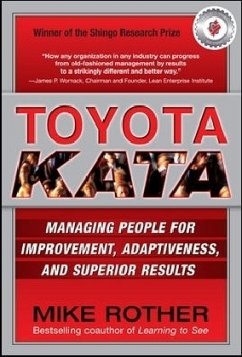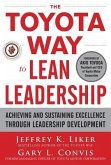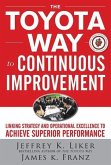Mike Rother
Toyota Kata: Managing People for Improvement, Adaptiveness and Superior Results
Mike Rother
Toyota Kata: Managing People for Improvement, Adaptiveness and Superior Results
- Gebundenes Buch
- Merkliste
- Auf die Merkliste
- Bewerten Bewerten
- Teilen
- Produkt teilen
- Produkterinnerung
- Produkterinnerung
A leading expert on Toyota provides the very first look at the company's people-management routines
Andere Kunden interessierten sich auch für
![The Toyota Way Fieldbook The Toyota Way Fieldbook]() Jeffrey LikerThe Toyota Way Fieldbook34,99 €
Jeffrey LikerThe Toyota Way Fieldbook34,99 €![The Innovation Secrets of Steve Jobs: Insanely Different Principles for Breakthrough Success The Innovation Secrets of Steve Jobs: Insanely Different Principles for Breakthrough Success]() Carmine GalloThe Innovation Secrets of Steve Jobs: Insanely Different Principles for Breakthrough Success21,99 €
Carmine GalloThe Innovation Secrets of Steve Jobs: Insanely Different Principles for Breakthrough Success21,99 €![The Toyota Way to Lean Leadership: Achieving and Sustaining Excellence through Leadership Development The Toyota Way to Lean Leadership: Achieving and Sustaining Excellence through Leadership Development]() Jeffrey LikerThe Toyota Way to Lean Leadership: Achieving and Sustaining Excellence through Leadership Development23,99 €
Jeffrey LikerThe Toyota Way to Lean Leadership: Achieving and Sustaining Excellence through Leadership Development23,99 €![TOYOTA WAY TO CNTNS IMPRVMNT TOYOTA WAY TO CNTNS IMPRVMNT]() Jeffrey LikerTOYOTA WAY TO CNTNS IMPRVMNT38,99 €
Jeffrey LikerTOYOTA WAY TO CNTNS IMPRVMNT38,99 €![Leading with Gratitude Leading with Gratitude]() Adrian GostickLeading with Gratitude28,99 €
Adrian GostickLeading with Gratitude28,99 €![Hbr's 10 Must Reads: The Essentials Hbr's 10 Must Reads: The Essentials]() Harvard Business ReviewHbr's 10 Must Reads: The Essentials22,99 €
Harvard Business ReviewHbr's 10 Must Reads: The Essentials22,99 €![Strategy Rules Strategy Rules]() David B. YoffieStrategy Rules25,99 €
David B. YoffieStrategy Rules25,99 €-
-
-
A leading expert on Toyota provides the very first look at the company's people-management routines
Hinweis: Dieser Artikel kann nur an eine deutsche Lieferadresse ausgeliefert werden.
Hinweis: Dieser Artikel kann nur an eine deutsche Lieferadresse ausgeliefert werden.
Produktdetails
- Produktdetails
- Verlag: McGraw-Hill Professional
- Seitenzahl: 336
- Erscheinungstermin: 1. September 2009
- Englisch
- Abmessung: 236mm x 161mm x 32mm
- Gewicht: 612g
- ISBN-13: 9780071635233
- ISBN-10: 0071635238
- Artikelnr.: 26485704
- Herstellerkennzeichnung
- Libri GmbH
- Europaallee 1
- 36244 Bad Hersfeld
- gpsr@libri.de
- Verlag: McGraw-Hill Professional
- Seitenzahl: 336
- Erscheinungstermin: 1. September 2009
- Englisch
- Abmessung: 236mm x 161mm x 32mm
- Gewicht: 612g
- ISBN-13: 9780071635233
- ISBN-10: 0071635238
- Artikelnr.: 26485704
- Herstellerkennzeichnung
- Libri GmbH
- Europaallee 1
- 36244 Bad Hersfeld
- gpsr@libri.de
Mike Rother is an engineer, a teacher, and a guest researcher at the Technical University Dortmund. Rother's work has bought him to numerous companies and hundreds of factories around the world, where he collaborates with people to test ideas and shares lessons learned. He splits his time between Ann Arbor, and Cologne, Germany. Rother has been entered into the Association of Manufacturing Excellence's Hall of Fame.
Introduction - Transforming our Understanding of Leadership and Management PART I: THE SITUATION Chapter 1: What Defines a Company that Thrives Long Term? PART II: KNOW YOURSELF Chapter 2: How Are We Approaching Process Improvement? Chapter 3: Philosophy and Direction Chapter 4: Origin and Effects of Our Current Management Approach PART III: THE IMPROVEMENT KATA: HOW TOYOTA CONTINUOUSLY IMPROVES Chapter 5: Planning: Establishing a Target Condition Chapter 6: Problem Solving and Adapting: Moving Toward a Target Condition PART IV: THE COACHING KATA: HOW TOYOTA TEACHES THE IMPROVEMENT KATA Chapter 7: Who Carries Out Process Improvement at Toyota? Chapter 8: The Coaching Kata - Leaders as Teachers PART V: REPLICATION: WHAT ABOUT OTHER COMPANIES? Chapter 9: Developing Improvement Kata Behavior in Your Organization Conclusion Bibliography Appendix 1: Where Do You Start With the Improvement Kata? Appendix 2: How to Analyze a Production Process
Introduction - Transforming our Understanding of Leadership and Management PART I: THE SITUATION Chapter 1: What Defines a Company that Thrives Long Term? PART II: KNOW YOURSELF Chapter 2: How Are We Approaching Process Improvement? Chapter 3: Philosophy and Direction Chapter 4: Origin and Effects of Our Current Management Approach PART III: THE IMPROVEMENT KATA: HOW TOYOTA CONTINUOUSLY IMPROVES Chapter 5: Planning: Establishing a Target Condition Chapter 6: Problem Solving and Adapting: Moving Toward a Target Condition PART IV: THE COACHING KATA: HOW TOYOTA TEACHES THE IMPROVEMENT KATA Chapter 7: Who Carries Out Process Improvement at Toyota? Chapter 8: The Coaching Kata - Leaders as Teachers PART V: REPLICATION: WHAT ABOUT OTHER COMPANIES? Chapter 9: Developing Improvement Kata Behavior in Your Organization Conclusion Bibliography Appendix 1: Where Do You Start With the Improvement Kata? Appendix 2: How to Analyze a Production Process








